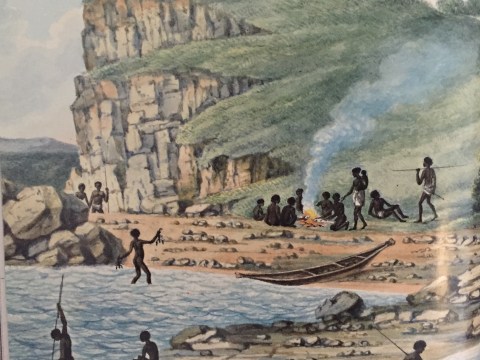CAPTAIN JAMES COOK
Our appreciation to Pam Willis Burden, Gail Cockburn and Douglas Shire Historical Society for sharing this content with us daily.
“Wednesday, 6th. Light Airs at East-South-East, with which we Steer’d West-North-West as the Land now lay; Course and distance saild since Yesterday noon West-North-West, 28 Miles”
In this situation we had the Mouth of a Bay all open extending from South 1/2 East to South-West 1/2 South, distance 2 Leagues.
This bay, which I named Cleveland Bay [now Townsville] appeared to be about 5 or 6 Miles in Extent every way.
The East point I named Cape Cleveland, and the West, Magnetical Head or Island, as it had much the appearance of an Island; and the Compass did not traverse well when near it.
They are both Tolerable high, and so is the Main Land within them, and the whole appeared to have the most rugged, rocky, and barren Surface of any we have yet seen.
However, it is not without inhabitants, as we saw smoke in several places in the bottom of the bay.
The Northermost land we had in sight at this time bore North-West; this we took to be an Island or Islands, for we could not trace the Main land farther than West by North.
From Banks’ Journal
6. Land made in Barren rocky capes; one in particular which we were abreast of in the morn appeard much like Cape Roxent; at noon 3 fires upon it.
Many Cuttle bones, Some sea weed and 2 or 3 Sea snakes were seen.
In the evening it fell quite calm and I went out in the small Boat and shot nectris nugax but saw nothing remarkable on the water; the weather most sultry hot in an open boat.
Nectris nugax is a type of petrel.

From “Endeavour” by Peter Aughton
There was already an HMS Endeavour, so Cook’s Endeavour was named a Bark.
Cook rejected any suggestion that one of the Navy’s smart frigates should be used. He wanted a vessel with a large storage capacity and shallow draught so that it could sail close to short in a few fathoms. His ideal vessel was the ‘cat-built’ bark used on the North Sea to carry coal from the Tyneside coal fields to the capital (London). He knew these vessels and was confident about handling them. The admiralty agreed and chose the Earl of Pembroke.
The Earl of Pembroke was built at Whitby in about 1765. She was 106 feet in length from stern to bowsprit, 29 feet 3 ins across the beam. Drew only 14 feet fully laden. Admiralty purchased her from Thomas Milner for £2800. She was refitted, completely re-rigged, given additional outside skin of thin planking over a layer of tarred felt and renamed as His Majesty’s bark the Endeavour.
Unlike the naval frigates of the time, she was squat, round and unadorned but ideally suited for sailing coastal waters. The arrangement of masts and rigging on the cat built bark was very similar to that of a navy three-master. She had cabin windows to port and starboard which were tastefully decorated on the outside and a row of five windows lined the rear of her stern cabin.
Cook’s Endeavour Journal NLA explains
‘Cat built’ meant she had a blunt bow, broad stern, wide beam, shallow draught, flat bottomed hull, three masts and was lightly rigged. Cat was an acronym for Coal And Timber.
She was 32 m long, and 9 metres wide and weighed 400 tonnes, she was designed to carry coal, not passengers. Her transformation required radical work and took her original cost of £2307 to more than £8000. Carpenters at Deptford yard not far from Greenwich added an extra skin of planks underwater, studded with flat topped nails to offer protection from Teredo Navalis, a wood-eating shipworm found in warm climates. They sheathed the boom of the hull in copper and built an extra deck below the main deck and furnished it with a series of cabins. Her top speed was 7 knots, about 13 kph.
On 30 July 1768 The Endeavour left Deptford yard and sailed to Plymouth. Cook was unhappy with the trim: “His majestys bark the Endeavour under my command Swims too much by the Head, and there being no means left to bring her down by the stern, but taking in more iron ballast abaft’ he complained. “Please order her to be supplyd with as much as may be found necessary for that purpose.”
He also requested that a green baize floor cloth be fitted to the great cabin, and the Navy Board agreed to both requests.
Think Different. Think DouglasNews.Network.
Your support matters. Support from our readers helps protect our editorial independence. Help us to report fearlessly on issues that affect our region, and to challenge those in power. Help us continue to deliver quality, trustworthy, fact-checked journalism that is free to access.
Please make a donation today.
Get Douglas News delivered direct to your inbox.
Share your stories and express your views.
Some of our best stories come from our readers. Tell us what’s happening in your life or community, or send in a Letter to the Editor to express your view.





